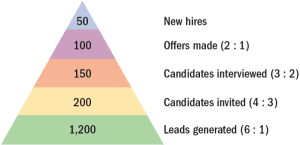what are the best recruitment systems?
1. Recruitment Planning 2. Strategy Development 3. Searching 4. Screening 5. Evaluation and Control
Recruitment Planning :
The first stage in the Recruitment Process is planning. Planning involves the translation of likely job vacancies and information about the nature of these jobs into a set of objectives is targets that specify the number and type of applicants to be planned.
Strategy Development
i.Make or Buy Employees
ii. Technological Sophistication of Recruitment and Selection Devices
iii. Geographic distribution of labor markets comprising job seekers
- Sources Of Recruitment :
Internal sources
External sources
Searching
i.Source Activation: Source Activation takes place when a job vacancy exists in the organization. If the organization has planned and well and done a good job of developing its source and search methods, activation soon results in a flood of applications.
ii. Selling: In selling, both the Message and Media deserve attention in the organization. The message refers to employment advertisements. Media refers to the source of any recruiting message. For example, Employment Exchanges, Advertises in Business magazines
Screening
The purpose of screening is to remove from the recruitment process at an early stage, those applicants who are visibly unqualified for the job. Effective screening can save a great deal of time and money. Care must be exercised to ensure that potentially good employees are not lost.
Evaluation and Control
It is necessary as considerable costs are incurred in the recruitment process. Statistical information should be gathered and evaluated to know the suitability of the recruitment process.
Recruiting Yield Pyramid
- Recruiting Yield Pyramid: It is used to calculate the number of applicants the organization must generate to hire the required number of employees.
For example, an organization should receive 1200 applications to be able to invite 200 viable candidates for hiring 50 new employees.

source: online
–The historical arithmetic relationships between recruitment leads and invitees, invitees and interviews, interviews and offers made, and offers made and offers accepted.
Internal Sources of Candidates: Hiring from Within
- Advantages
–Foreknowledge of candidates’ strengths and weaknesses
–More accurate view of the candidate’s skills
–Candidates have a stronger commitment to the company
–Increases employee morale
–Less training and orientation required
- Disadvantages
–Failed applicants become discontented
–Time wasted interviewing inside candidates who will not be considered
–Inbreeding of the status quo
Finding Internal Candidates
- Job posting
–Publicizing an open job to employees (often by literally posting it on bulletin boards) and listing its attributes.
- Rehiring former employees
–Advantages:
- They are known quantities.
- They know the firm and its culture.
–Disadvantages:
- They may have less-than-positive attitudes.
- Rehiring may send the wrong message to current employees about how to get ahead.
Succession planning
–The process of ensuring a suitable supply of successors for current and future senior or key jobs.
Succession planning steps:
–Identifying and analyzing key jobs.
–Creating and assessing candidates.
–Selecting those who will fill the key positions.
Outside Sources of Candidates
- Advertising
–The Media: The selection of the best medium depends on the positions for which the firm is recruiting.
- Newspapers (local and specific labor markets)
- Trade and professional journals
- Internet job sites
- Marketing programs
- Constructing an effective ad
–Wording related to job interest factors should evoke the applicant’s attention, interest, desire, and action (AIDA) and create a positive impression of the firm.
- Reasons for using a private employment agency:
–When a firm doesn’t have an HR department and is not geared to doing recruiting and screening.
–The firm has found it difficult in the past to generate a pool of qualified applicants.
–The firm must fill a particular opening quickly.
–There is a perceived need to attract a greater number of minority or female applicants.
–The firm wants to reach currently employed individuals, who might feel more comfortable dealing with agencies than with competing companies.
–The firm wants to cut down on the time it’s devoting to recruiting.
- Avoiding problems with employment agencies:
–Give the agency an accurate and complete job description.
–Make sure tests, application blanks, and interviews are part of the agency’s selection process.
–Periodically review data on candidates accepted or rejected by your firm, and by the agency. Check on the effectiveness and fairness of the agency’s screening process.
–Screen the agency. Check with other managers or HR people to find out which agencies have been the most effective at filling the sorts of positions needed to be filled.
–Review the Internet and a few back issues of the Sunday classified ads to discover the agencies that handle the positions to be filled.
recruitment and selection
The selection has been regarded as the most important function of the HR department. It ensures the organization; has the right number, the right kind of people at the right place, and at the right time.
Meaning and Definitions:
“It is the process of differentiating between applicants in order to identify (and hire) those with a greater likelihood of success in a job.”
1. Preliminary Interview 2. Selection Tests 3. Employment Interview 4. Reference and Background Checks 5. Selection Decision 6. Physical Examinations 7. Job Offer 8. Contract Of Employment 9. Evaluation of Selection program These recruitment systems help to find best employee in an organization. Warch this video abut recruitment process step by step-

